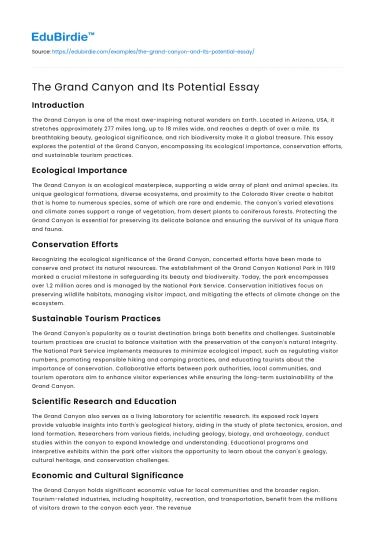Introduction
The Grand Canyon is one of the most awe-inspiring natural wonders on Earth. Located in Arizona, USA, it stretches approximately 277 miles long, up to 18 miles wide, and reaches a depth of over a mile. Its breathtaking beauty, geological significance, and rich biodiversity make it a global treasure. This essay explores the potential of the Grand Canyon, encompassing its ecological importance, conservation efforts, and sustainable tourism practices.
Ecological Importance
The Grand Canyon is an ecological masterpiece, supporting a wide array of plant and animal species. Its unique geological formations, diverse ecosystems, and proximity to the Colorado River create a habitat that is home to numerous species, some of which are rare and endemic. The canyon's varied elevations and climate zones support a range of vegetation, from desert plants to coniferous forests. Protecting the Grand Canyon is essential for preserving its delicate balance and ensuring the survival of its unique flora and fauna.
Save your time!
We can take care of your essay
- Proper editing and formatting
- Free revision, title page, and bibliography
- Flexible prices and money-back guarantee
Conservation Efforts
Recognizing the ecological significance of the Grand Canyon, concerted efforts have been made to conserve and protect its natural resources. The establishment of the Grand Canyon National Park in 1919 marked a crucial milestone in safeguarding its beauty and biodiversity. Today, the park encompasses over 1.2 million acres and is managed by the National Park Service. Conservation initiatives focus on preserving wildlife habitats, managing visitor impact, and mitigating the effects of climate change on the ecosystem.
Sustainable Tourism Practices
The Grand Canyon's popularity as a tourist destination brings both benefits and challenges. Sustainable tourism practices are crucial to balance visitation with the preservation of the canyon's natural integrity. The National Park Service implements measures to minimize ecological impact, such as regulating visitor numbers, promoting responsible hiking and camping practices, and educating tourists about the importance of conservation. Collaborative efforts between park authorities, local communities, and tourism operators aim to enhance visitor experiences while ensuring the long-term sustainability of the Grand Canyon.
Scientific Research and Education
The Grand Canyon also serves as a living laboratory for scientific research. Its exposed rock layers provide valuable insights into Earth's geological history, aiding in the study of plate tectonics, erosion, and land formation. Researchers from various fields, including geology, biology, and archaeology, conduct studies within the canyon to expand knowledge and understanding. Educational programs and interpretive exhibits within the park offer visitors the opportunity to learn about the canyon's geology, cultural heritage, and conservation challenges.
Economic and Cultural Significance
The Grand Canyon holds significant economic value for local communities and the broader region. Tourism-related industries, including hospitality, recreation, and transportation, benefit from the millions of visitors drawn to the canyon each year. The revenue generated supports local businesses, employment opportunities, and community development. Moreover, the Grand Canyon holds immense cultural importance for Native American tribes, who have longstanding connections to the land and continue to engage in traditional practices, ceremonies, and stewardship.
Conclusion
The Grand Canyon represents an unparalleled synthesis of natural wonder, conservation, and tourism. Its ecological importance, conservation efforts, sustainable tourism practices, scientific research, and economic significance collectively contribute to its immense potential. Preserving the Grand Canyon's pristine beauty and ecological balance requires continued dedication and collaboration from individuals, communities, and governing bodies. By striking a harmonious balance between conservation and tourism, we can ensure that future generations can experience the grandeur of the canyon while respecting its fragility. The Grand Canyon stands as a testament to the power and beauty of nature, and it is our responsibility to protect and cherish this extraordinary wonder for years to come.






 Stuck on your essay?
Stuck on your essay?

